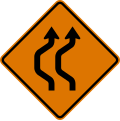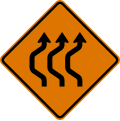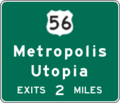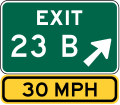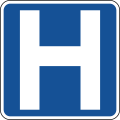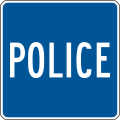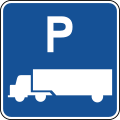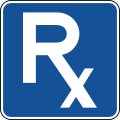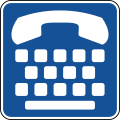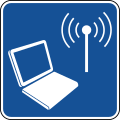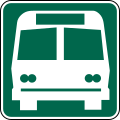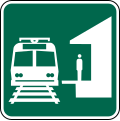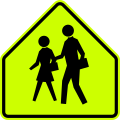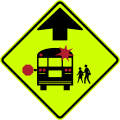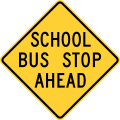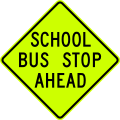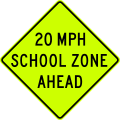Road signs in the United States

In the United States, road signs are, for the most part, standardized by federal regulations, most notably in the Manual on Uniform Traffic Control Devices (MUTCD) and its companion volume the Standard Highway Signs (SHS).
Regulatory signs[change | change source]
Regulatory signs give instructions to motorists, pedestrians, and cyclists. Signs including Stop, Yield, No Turns, No Trucks, No Parking, No Stopping, Minimum Speed, Right Turn Only, Do Not Enter, Weight Limit, and Speed Limit are considered regulatory signs. Some have special shapes, such as the octagon for the Stop sign and the crossbuck for railroad crossings. Some signs can be localized, such as No Parking, and some are found only in state and local jurisdictions, as they are based on state or local laws, such as New York City's "Don't Block the Box" signs. These signs are in the R series of signs in the MUTCD and typically in the R series in most state supplements or state MUTCDs.
R1 series: Stop and yield[change | change source]
The MUTCD's R1 series is for Stop and Yield. As not all situations are covered, several states have their own standards in addition to the MUTCD. The 4-WAY and 3-WAY plaques (R1-3) were deprecated in the 2009 Edition of the MUTCD in favor of the ALL WAY plaque (R1-3P).
-
R1-1
Stop -
R1-2
Yield -
R1-2aP
To oncoming traffic (plaque) -
R1-3P
All way (plaque) -
R1-5
Yield here to pedestrians -
R1-5a
Yield here to pedestrians -
R1-5b
Stop here for pedestrians -
R1-5c
Stop here for pedestrians -
R1-6b
In-street school crossing -
R1-6b
In-street school crossing (within crosswalk) -
R1-6c
In-street school crossing -
R1-7
Wait on stop -
R1-8
Go on slow -
R1-10P
Except right turn (plaque)
R2 series: Speed limit[change | change source]
The MUTCD's R2 series is for speed limit signs. Some state supplements and state MUTCDs place various speed limit signs in other series. As all situations are not covered, several states have their own standards in addition to the MUTCD. Speed limits in the United States are always in miles per hour. Metric speed limit signs in kilometers per hour used to be authorized but extremely rare, usually seen near the borders with Canada and Mexico, both of which use the metric system.[1] They have been discontinued as of 2012. Many states, however, disallow the use of metric signs on state-maintained roads due to MUTCD restrictions,[2] increasing the rarity of such signs.
-
R2-1
Speed limit -
R2-1
Speed limit (metric) -
R2-2P
Truck speed limit (plaque) -
R2-2P
Truck speed limit (metric) -
R2-3P
Night speed limit (plaque) -
R2-3P
Night speed limit (metric) -
R2-4P
Minimum speed limit (plaque) -
R2-4P
Minimum speed limit (metric) -
R2-4a
Combined speed limit -
R2-5P
Unless otherwise posted (plaque) -
R2-6bP
$XX fine (plaque) -
R2-10
Begin higher/double fines -
R2-11
End double/higher fines
R3 series: Lane usage and turns[change | change source]
The MUTCD's R3 series of signs is for lane usage and turn signs. As all situations are not covered, several states have their own standards in addition to the MUTCD.
-
R3-1
No right turn -
R3-1a
No right turn across tracks -
R3-2
No left turn -
R3-2a
No left turn across tracks -
R3-3
No turns -
R3-4
No U-turn -
R3-5L
Left turn only -
R3-5R
Right turn only -
R3-5a
Straight through only -
R3-5b
Left lane (plaque) -
R3-5e
Center lane (plaque) -
R3-5f
Right lane (plaque) -
R3-5g
Bus lane (plaque) -
R3-6L
Optional movement lane control, straight through and left turn -
R3-6R
Optional movement lane control, straight through and right turn -
R3-7L
Left lane must turn left -
R3-7R
Right lane must turn right -
R3-8
Advance intersection lane control (two lanes) -
R3-8a
Advance intersection lane control (three lanes) -
R3-8b
Advance intersection lane control (three lanes) -
R3-9a
Two-way left turn only (overhead) -
R3-9b
Two-way left turn only (post-mounted) -
R3-9e
Reversible lane control (overhead) -
R3-9f
Reversible lane control (post-mounted) -
R3-9g
Advance reversible lane control transition -
R3-9h
Advance reversible lane control transition -
R3-9i
End reverse lane -
R3-10
Preferential lane vehicle occupancy definition (post-mounted) -
R3-10a
Preferential lane vehicle occupancy definition (post-mounted) -
R3-11
Preferential lane operation, high-occupancy vehicles (post-mounted) -
R3-11a
Preferential lane operation, high-occupancy vehicles (post-mounted) -
R3-11d
Preferential lane operation (post-mounted) -
R3-11b
Preferential lane operation, high-occupancy vehicles, full-time (post-mounted) -
R3-12
Preferential lane ahead, high-occupancy vehicles (post-mounted) -
R3-12a
Preferential lane ends, high-occupancy vehicles (post-mounted) -
R3-12
Preferential lane ends, high-occupancy vehicles (post-mounted) -
R3-13
Preferential lane vehicle occupancy definition (overhead) -
R3-13a
Preferential lane vehicle occupancy definition (overhead) -
R3-14
HOV lane operation (overhead) -
R3-14a
HOV lane operation (overhead) -
R3-14b
HOV lane operation (overhead) -
R3-15
HOV lane ahead (overhead) -
R3-15a
HOV lane begins XX miles (overhead) -
R3-17
Bike lane -
R3-18
No U or left turn -
R3-23
All turns from right lane (used at jughandles) -
R3-24
All turns (diagonal right arrow) (used at jughandles) -
R3-24a
U and left turns (diagonal right arrow) (used at jughandles) -
R3-27
No straight through -
R3-29P
Pay toll (plaque) -
R3-33R
Right lane must exit
R4 series: Regulation of movement[change | change source]
The MUTCD's R4 series of signs is for the regulation of movement signs. As all situations are not covered, several states have their own standards in addition to the MUTCD.
-
R4-1
Do not pass -
R4-2
Pass with care -
R4-3
Slower traffic keep right -
R4-4
Begin right turn lane yield to bikes -
R4-5
Trucks use right lane -
R4-6
Truck lane 500 feet -
R4-7
Keep right -
R4-7a
Keep right -
R4-7b
Keep right -
R4-7c
Keep right of obstacle -
R4-8
Keep left -
R4-8a
Keep left -
R4-8b
Keep left -
R4-8c
Keep left of obstacle -
R4-9
Stay in lane -
R4-10
Runaway vehicles only -
R4-11
Cyclists may use full lane -
R4-12
Slow vehicles with five or more following vehicles must use turn-out -
R4-13
Slow vehicles must use turn-out ahead -
R4-14
Slow vehicles must turn out -
R4-16
Keep right except to pass -
R4-17
Do not drive on shoulder -
R4-18
Do not pass on shoulder
R5 series: Exclusionary[change | change source]
The MUTCD's R5 series of signs is for exclusionary signs. As all situations are not covered, several states have their own standards in addition to the MUTCD. The most common of these signs is the do not enter sign.
-
R5-1
Do not enter -
R5-1a
Wrong way -
R5-1b
Wrong way for bicycles -
R5-2
No trucks -
R5-3
No motorized vehicles -
R5-4
No commercial vehicles -
R5-5
No lugged vehicles -
R5-6
No bicycles -
R5-7
No non-motorized traffic -
R5-8
No motor driven cycles -
R5-10
No pedestrians, bicycles or motor driven cycles -
R5-10a
No pedestrians, bicycles or motor driven cycles on freeway -
R5-10b
No pedestrians or bicycles -
R5-10c
No pedestrians -
R5-11
No unauthorized vehicles
R6 series: One way and divided highway[change | change source]
The MUTCD's R6 series of signs is for one way and divided highway signs. As all situations are not covered, several states have their own standards in addition to the MUTCD. The most common of these signs is the One Way sign.
-
R6-1R
One way (right) -
R6-1L
One way (left) -
R6-2R
One way (with arrow) (right) -
R6-L
One way (with arrow) (left) -
R6-3
Divided highway crossing -
R6-3a
Divided highway crossing, T-intersection -
R6-4
Chevron roundabout directional -
R6-4a
Chevron roundabout (three chevrons) -
R6-4b
Chevron roundabout (four chevrons) -
R6-5P
Roundabout circulation (plaque) -
R6-6
Begin one way -
R6-7
End one way
R7 series: Parking[change | change source]
The MUTCD allows for three types of parking signs: permissive, No Parking, and No Standing. However, in most states, there is an additional more restrictive one, No Stopping. These signs are found in the R7 series of signs in the MUTCD. As all situations are not covered, several states and local governments have their own standards in addition to the MUTCD. Permissive parking signs allow for parking for either an unlimited or varied amount of time. They are often used in conjunction with parking meters and parking permits. They are specified by the MUTCD to be green on white. Local variations occur with additional information and slightly different designs. No Parking signs indicate that loading or unloading while temporarily stopped is permitted, but the driver must not leave the vicinity of the vehicle.[3] Some No Parking signs display time restrictions, while others are permanent restrictions. There are also temporary versions of the signs, often of similar design to the permanent ones. These signs are specified by the MUTCD to be red on white, although local variations occur. No Standing signs indicate that stopping temporarily to load or unload passengers is allowed, but vehicles cannot be stopped at the location for longer periods of time, even if the driver remains with the vehicle.[3] As with no parking signs, some restrictions displayed on the signs are permanent, and some are time-based.
-
R7-1
No parking any time -
R7-2
No parking from 8:30 am to 5:30 pm -
R7-2a
No parking from 8:30 am to 5:30 pm (alternative) -
R7-3
No parking except Sundays and Holidays -
R7-4
No standing any time -
R7-5
One hour parking time -
R7-108
Two hour parking time -
R7-6
No parking, loading zone -
R7-20
Parking fee station -
R7-8
Reserved parking (wheelchair) -
R7-8aP
Van accessible -
R7-107
No parking, bus stop -
R7-22
Parking pay parking -
R7-200a
No parking and one hour parking time (combined) -
R7-201P
Tow away zone
R8 series: Parking and emergency restrictions[change | change source]
The MUTCD's R8 series of signs is for parking restriction and emergency restriction signs. As all situations are not covered, several states have their own standards in addition to the MUTCD.
-
R8-1
No parking on pavement -
R8-2
No parking except on shoulder -
R8-3
No parking -
R8-3a
No parking (text) -
R8-3bP
Exception of Sundays and holidays -
R8-3c
On pavement -
R8-3d
On bridge -
R8-3eP
On tracks plaque -
R8-3fP
Except on shoulder plaque -
R8-3gP
Loading zone -
R8-4
Emergency parking only -
R8-5
No stopping on pavement -
R8-6
No stopping except on shoulder -
R8-7
Emergency stopping only -
R8-8
Do not stop on tracks -
R8-9
Tracks out of service -
R8-10a
Stop here when flashing
R9 series: Bicycles and pedestrians[change | change source]
The MUTCD's R9 series of signs is for bicycle and pedestrian signs. As all situations are not covered, several states have their own standards in addition to the MUTCD.
-
R9-1
Walk on left facing traffic -
R9-2
Cross only at cross walks -
R9-3
No pedestrians crossing (symbol) -
R9-3a
No pedestrians crossing -
R9-3b
Use crosswalk (plaque) -
R9-4
No hitchhiking (symbol) -
R9-4a
No hitchhiking -
R9-7
Bicycles left pedestrians right -
R9-10
Sidewalk Closed Use Other Side -
R9-13
No skaters -
R9-14
No equestrians -
R9-15
No snowmobiles -
R9-16
No all-terrain vehicles -
R9-19P
Except on shoulder (plaque)
R10 series: Traffic signal[change | change source]
The MUTCD's R10 series of signs is for traffic signal related signs. As all situations are not covered, several states have their own standards in addition to the MUTCD.
-
R10-1
Cross only on green -
R10-2
Cross only on pedestrian signal -
R10-3
Push button for walk signal -
R10-3a
Push button to cross street, wait for pedestrian signal -
R10-3b
Crosswalk signal instructions -
R10-3c
Crosswalk signal instructions -
R10-3d
Crosswalk signal instructions -
R10-3e
Crosswalk signal instructions -
R10-3f
Crosswalk signal instructions -
R10-3g
Crosswalk signal instructions -
R10-3h
Crosswalk signal instructions -
R10-3i
Crosswalk signal instructions -
R10-4
Push button for green -
R10-4a
Push button to cross street, wait for green -
R10-5
Left on green arrow only -
R10-6
Stop here on red -
R10-6a
Stop here on red (alternate) -
R10-7
Do not block intersection -
R10-8
Use lane with green arrow -
R10-10L
Left turn signal -
R10-10R
Right turn signal -
R10-11
No turn on red -
R10-11a
No turn on circular red -
R10-12
Left turn yield on green -
R10-12a
Left turn yield on flashing yellow arrow -
R10-12b
Left turn yield to bicycle -
R10-13
Emergency signal -
R10-14
Emergency signal - stop on flashing red -
R10-14a
Emergency signal - stop on flashing red (overhead) -
R10-16
U-turn yield to right turn -
R10-17a
Right on red arrow after stop -
R10-18
Traffic laws photo enforced -
R10-18a
Traffic signal photo enforced -
R10-19aP
Photo enforced (plaque) -
R10-20aP
Days & times (plaque) (for use with R10-11 series) (2 lines) -
R10-20aP
Days & times (plaque) (for use with R10-11 series) (3 lines) -
R10-22
Bicycles to request green wait on line -
R10-23
Crosswalk - stop on red -
R10-23a
Stop on red - yield on flashing red after stop -
R10-25
Push button to turn on warning lights -
R10-27
Left turn yield on flashing red arrow after stop -
Left turn yield on flashing yellow arrow, version 1
-
Left turn yield on flashing arrow, version 2
-
R10-28
XX vehicles per green -
R10-29
XX vehicles per green each lane -
R10-30
Right turn on red must yield to U-turn -
R10-31P
At signal (plaque) -
R10-32P
Push button for 2 seconds for extra crossing time
R11 series: Road closed[change | change source]
The MUTCD's R11 series of signs is for road closure-related signs. As all situations are not covered, several states have their own standards in addition to the MUTCD.
-
R11-1
Keep off median -
R11-2
Road closed -
R11-2c
Path closed -
R11-3
Road closed XX miles ahead, local traffic only -
R11-3a
Street closed XX miles ahead, local traffic only -
R11-3b
Bridge out XX miles ahead, local traffic only -
R11-4
Road closed to thru traffic
R12 series: Weight limits[change | change source]
The MUTCD's R12 series of signs is for weight limit-related signs. As all situations are not covered, several states have their own standards in addition to the MUTCD.
-
R12-1
Weight limit -
R12-2
Axle weight limit -
R12-3
Truck weight limit -
R12-4
Weight limit with per axle and gross -
R12-5
Weight limit with truck symbols
R13 series: Weigh stations[change | change source]
The MUTCD's R13 series of signs is for weigh station related signs. As all situations are not covered, several states have their own standards in addition to the MUTCD.
-
R13-1
Trucks over X tons must enter weigh station next right
R14 series: Truck routes[change | change source]
The MUTCD's R14 series of signs is for truck route-related signs. As not all situations are covered, several states have their own standards in addition to the MUTCD.
-
R14-1
Truck route sign -
R14-2
Hazardous material route -
R14-3
Hazardous material prohibited -
R14-4
National Network Route -
R14-5
National Network prohibited
R15 series: Rail and light rail[change | change source]
The MUTCD's R15 series of signs is for rail- and light rail-related signs. As all situations are not covered, several states have their own standards in addition to the MUTCD.
-
R15-1
Railroad crossing (crossbuck) -
R15-2P
Three tracks -
R15-3P
This railroad stop is exempt from the horn blowing -
R15-4a
Light rail only in right lane -
R15-4b
Light rail only in left lane -
R15-4c
Light rail only in center lane -
R15-5
Do not pass stopped trains -
R15-6
Do not drive on tracks -
R15-7
Divided highway transit rail crossing -
R15-7a
Divided highway transit rail crossing (T-intersection) -
R15-8
Look both ways at track
R16 series: Seat belts and headlight use[change | change source]
The MUTCD's R16 series of signs is for seat belt and headlight use-related signs. As all situations are not covered, several states have their own standards in addition to the MUTCD.
-
R16-1
Wear seat belt -
R16-4
Fender bender -
R16-6
Lights on when raining -
R16-8
Turn on headlights -
R16-9
Check headlights
Warning signs[change | change source]
Warning signs are found in the W series of the national MUTCD. They highlight existing conditions, such as a curve, school, dead end street, or traffic signal. They can also warn of possible danger such as bumps, bicycles, low flying aircraft, or emergency vehicles. They are either yellow or fluorescent yellow in color and, with a few exceptions, are usually diamond-shaped and sometimes have square or rectangular smaller signs or plaques associated with them. Most W series signs can also be found with orange backgrounds for temporary use in situations such as construction zones. Some of the temporary-use signs are for use only in temporary situations.
W1 series: Horizontal alignment[change | change source]
The MUTCD's W1 series of signs is for warning signs relating to horizontal alignment. As not all situations are covered, several states have their own standards in addition to the MUTCD.
-
W1-1R
Turn (right) -
W1-1L
Turn (left) -
W1-2R
Curve (right) -
W1-2L
Curve (left) -
W1-3R
Reverse turn (right) -
W1-3L
Reverse turn (left) -
W1-4R
Reverse curve (right) -
W1-4L
Reverse curve (right) -
CW1-4R
Single lane shift (left to right) -
CW1-4L
Single lane shift (right to left) -
CW1-4bR
Double lane shift (left to right) -
CW1-4bL
Double lane shift (right to left) -
CW1-4cR
Triple lane shift (left to right) -
CW1-4cL
Triple lane shift (right to left) -
W1-5R
Winding road (right) -
W1-5L
Winding road (left) -
W1-6R
Arrow (right) -
W1-6L
Arrow (left) -
W1-7
Two-direction large arrow -
W1-8R
Chevron (right) -
W1-8L
Chevron (left) -
W1-10R
Curve with side road (right) -
W1-10L
Curve with side road (left) -
W1-10aR
Intersection in curve (right) -
W1-10aL
Intersection in curve (left) -
W1-10bR
Intersection in curve (right) -
W1-10bL
Intersection in curve (left) -
W1-10cR
Intersection in curve (right) -
W1-10cL
Intersection in curve (left) -
W1-10dR
Intersection in curve (right) -
W1-10dL
Intersection in curve (left) -
W1-10eR
Intersection in curve (right) -
W1-10eL
Intersection in curve (left) -
W1-11R
Hairpin curve (right) -
W1-11L
Hairpin curve (left) -
W1-13R
Truck rollover warning (right) -
W1-13L
Truck rollover warning (left) -
W1-15R
270 degree loop curve (right) -
W1-15L
270 degree loop curve (left)
W2 series: Intersections[change | change source]
The MUTCD's W2 series of signs is for warning signs relating to intersections. As not all situations are covered, several states have their own standards in addition to the MUTCD.
-
W2-1
Crossroad -
W2-2L
Side road left -
W2-2R
Side road right -
W2-3L
Slanted side road left -
W2-3R
Slanted side road right -
W2-4
T-intersection -
W2-5
Y-intersection -
W2-6
Roundabout -
W2-7L
Offset side roads -
W2-8R
Double side roads
W3 series: Advance traffic control[change | change source]
The MUTCD's W3 series of signs is for warning signs relating to advance traffic controls. The MUTCD provides options for graphic and text signs. As not all situations are covered, several states have their own standards in addition to the MUTCD.
-
W3-1
Stop sign ahead -
W3-2
Yield sign ahead -
W3-3
Traffic lights ahead -
W3-4
Be prepared to stop -
W3-5
Speed limit ahead -
W3-5A
Speed zone ahead -
W3-6
Draw bridge ahead -
W3-7
Ramp meter ahead -
W3-8
Ramp metered when flashing
W4 series: Lanes and merges[change | change source]
The MUTCD's W4 series of signs is for warning signs relating to lane merges and added lanes, as well as lane endings. As not all situations are covered, several states have their own standards in addition to the MUTCD.
-
W4-1R
Merge (right) -
W4-1L
Merge (left) -
W4-2R
Lane ends (right) -
W4-2L
Lane ends (right) -
W4-3R
Added right lane -
W4-3L
Added left lane -
W4-4P
Cross traffic does not stop (plaque) -
W4-5R
Merge right (entering roadway) -
W4-5L
Merge left (entering roadway) -
W4-5aP
No merge area (plaque) -
W4-6R
Added right lane (entering roadway) -
W4-6L
Added left lane (entering roadway)
W5 series: Road width restrictions[change | change source]
The MUTCD's W5 series of signs is for warning signs relating to road width restrictions. The MUTCD provides options for graphic and text signs. As not all situations are covered, several states have their own standards in addition to the MUTCD.
-
W5-1
Road narrows -
W5-2
Narrow bridge -
W5-3
One lane bridge -
W5-4a
Path narrows -
W5-4A
Bikeway narrows
W6 series: Divided highway[change | change source]
The MUTCD's W6 series of signs is for warning signs relating to divided highways. The MUTCD provides options for graphic and text signs. As not all situations are covered, several states have their own standards in addition to the MUTCD.
-
W6-1
Divided highway starts -
W6-2
Divided highway ends -
W6-3
Two-way traffic
W7 series: Hills[change | change source]
The MUTCD's W7 series of signs is for warning signs relating to hills. As not all situations are covered, several states have their own standards in addition to the MUTCD.
-
W7-1
Steep grade/hill -
W7-1A
Hill -
W7-1B
Steep grade/hill percentage -
W7-2P
Use low gear -
W7-2bP
Trucks use lower gear -
W7-3P
X% grade ahead -
W7-3aP
Next XX miles ahead -
W7-3bP
X% grade XX miles ahead -
W7-4
Runaway truck ramp ahead -
W7-4b
Runaway truck ramp (right) -
W7-4bL
Runaway truck ramp (left) -
W7-4b
Runaway truck ramp this lane -
W7-4c
Truck escape ramp -
W7-4dP
Sand -
W7-4eP
Gravel -
W7-4fP
Paved -
W7-5
Hill (bike) -
W7-6
Hill blocks view
W8 series: Pavement and roadway conditions[change | change source]
The MUTCD's W8 series of signs is for warning signs relating to pavement and roadway conditions. As not all situations are covered, several states have their own standards in addition to the MUTCD.
-
W8-1
Bump -
W8-2
Dip -
W8-3
Pavement ends -
W8-4
Soft shoulder -
W8-5
Slippery when wet ahead -
W8-7
Loose gravel -
W8-8
Rough road -
W8-10
Bicycle slippery when wet ahead -
W8-11
Uneven lanes -
W8-12
No center line -
W8-13
Bridge ices before road -
W8-14
Fallen rocks -
W8-16
Metal bridge deck -
W8-18
Road may flood -
W8-19
Flood gauge -
W8-21
Gusty Winds Area -
W8-22
Fog area -
W8-23
No shoulder ahead -
W8-25
Shoulder ends
W9 series: Lane transitions[change | change source]
The MUTCD's W9 series of signs is for warning signs relating to lane transitions. As not all situations are covered, several states have their own standards in addition to the MUTCD.
-
W9-1L
Left lane ends -
W9-1R
Right lane ends -
W9-2R
Lane ends merge right -
W9-2L
Lane ends merge left -
CW9-3L
Center lane closed ahead (text sign used from 2000 to 2023) -
CW9-3L
Center lane closed ahead (symbol sign used since 2023)
W10 series: Railroad crossings[change | change source]
The MUTCD's W10 series of signs is for warning signs relating to railroad crossings. As not all situations are covered, several states have their own standards in addition to the MUTCD.
-
W10-1
Railroad crossing ahead -
W10-1aP
Exempt (plaque) -
W10-2R
Crossroads with parallel tracks (right) -
W10-2L
Crossroads with parallel tracks (left) -
W10-3R
Side road with parallel tracks (right) -
W10-3L
Side road with parallel tracks (left) -
W10-4R
T intersection with parallel tracks (right) -
W10-4L
T intersection with parallel tracks (left) -
W10-5
Low ground clearance railroad crossing -
W10-5P
Low ground clearance plaque -
W10-7
Light rail activated sign -
W10-8
Trains may exceed XX mph -
W10-9
No train horn warning -
W10-9P
No train horn plaque -
W10-11
Storage space symbol -
W10-11a
XX feet between tracks and highway -
W10-11b
XX feet between highway and tracks behind you -
W10-12R
Skewed crossing ahead -
W10-13P
No gates or lights (plaque) -
W10-14P
Next crossing (plaque) -
W10-14aP
Use next crossing (plaque) -
W10-15P
Rough crossing (plaque)
W11 series: Advance warnings[change | change source]
The MUTCD's W11 series of signs is for warning signs relating to advance warnings. The MUTCD allows use of a fluorescent yellow-green background color for signs relating to non-motorized vehicles crossing the road.[4] As not all situations are covered, several states have their own standards in addition to the MUTCD.
-
W11-3
Deer -
W11-4
Cattle -
W11-5
Farm vehicles -
W11-6
Snowmobile -
W11-7
Equestrian -
W11-8
Emergency vehicle -
W11-9
Handicapped[c] -
W11-10
Truck -
W11-11
Golf cart -
W11-14
Horse-drawn vehicles -
W11-16
Bear -
W11-17
Sheep -
W11-18
Ram -
W11-19
Donkey -
W11-20
Elk -
W11-21
Moose -
W11-22
Wild horse
W12 series: Low Clearance Warnings[change | change source]
The MUTCD's W12 series of signs is for warning signs relating to low clearance. Metric low bridge signs in meters used to be authorized but extremely rare, usually seen near the borders with Canada and Mexico, both of which use the metric system.[1] They have been discontinued as of 2012. Many states, however, disallowed the use of metric signs on state-maintained roads due to system restrictions, increasing the rarity of such signs. As not all situations are covered, several states have their own standards in addition to the MUTCD.
-
W12-1
Double arrow -
W12-2
Low clearance -
W12-2
Low clearance (metric) -
W12-2a
Sign displays height of bridge
W13 series: Advisory speeds[change | change source]
The MUTCD's W13 series of signs is for warning signs relating to advisory speeds. Speed limits in the United States are always in miles per hour. Metric advisory speed signs in kilometers per hour used to be authorized but extremely rare, usually seen near the borders with Canada and Mexico, both of which use the metric system.[1] They have been discontinued as of 2012. Many states, however, disallowed the use of metric signs on state-maintained roads due to system restrictions, increasing the rarity of such signs. As not all situations are covered, several states have their own standards in addition to the MUTCD.
-
W13-1P
Speed advisory -
W13-1
Speed advisory metric -
W13-2
Exit speed advisory -
W13-3
Ramp speed advisory -
W13-6
Exit speed advisory (270 degree loop curve) -
W13-7
Ramp speed advisory (270 degree loop curve)
W14 series: Dead end streets and no passing zones[change | change source]
The MUTCD's W14 series of signs is for warning signs relating to dead-end streets and no-passing zones. As all situations are not covered, several states and local governments have additional signs for other types of situations not covered by the MUTCD. As not all situations are covered, several states have their own standards in addition to the MUTCD.
-
W14-1
Dead end -
W14-1aR
Dead end on the right -
W14-1aL
Dead end on the left -
W14-2
No outlet -
W14-2aR
No outlet on the right -
W14-2aL
No outlet on the left -
W14-3
No passing zone
W15 series: Playgrounds[change | change source]
The MUTCD's W15 series of signs is for warning signs relating to playgrounds. As not all situations are covered, several states have their own standards in addition to the MUTCD.
W16 series: Supplemental plaques[change | change source]
The MUTCD's W16 series of signs is for supplemental plaques for warning signs. As not all situations are covered, several states have their own standards in addition to the MUTCD.
-
W16-2P
XX feet -
W16-2aP
XX feet -
W16-3P
X miles -
W16-3aP
X miles -
W16-4P
Next XX feet -
W16-18P
Notice -
W16-5PR
Supplemental arrow to the right (plaque)[d] -
W16-5PL
Supplemental arrow to the left (plaque)[d] -
W16-6PR
Supplemental arrow to the right (plaque)[d] -
W16-6PL
Supplemental arrow to the left (plaque)[d] -
W16-7PR
Downward diagonal arrow to the right (plaque)[d] -
W16-7PL
Downward diagonal arrow to the left (plaque)[d] -
W16-8P
Advance Street Name Plaque -
W16-8aP
Advance Street Name Plaque (double arrow) -
W16-9P
Ahead -
W16-10aP
Photo enforced -
W16-11
HOV -
W16-12
Roundabout junction plaque -
W16-13P
When flashing -
W16-15P
New -
W16-17P
Toll (plaque)
W17 series: Speed humps[change | change source]
The MUTCD's W17 series of signs is for warnings relating to speed humps. As not all situations are covered, several states have their own standards in addition to the MUTCD.
-
W17-1
Speed hump
W18 series: No traffic signs[change | change source]
The MUTCD's W18 series of signs is for warnings relating to no further traffic signs. As not all situations are covered, several states have their own standards in addition to the MUTCD.
-
W18-1
No traffic signs
W19 series: Freeway or expressway end signs[change | change source]
The MUTCD's W19 series of signs is for warning signs relating to the end of a freeway or expressway. As not all situations are covered, several states have their own standards in addition to the MUTCD.
-
W19-1
Freeway ends XX mile -
W19-2
Expressway ends XX mile -
W19-3
Freeway ends -
W19-4
Expressway ends -
W19-5
All traffic must exit
W20 series: Work zones[change | change source]
The MUTCD's W20 series of signs is for warning signs relating to work zones. These signs are typically orange background ones used for temporary situations. As not all situations are covered, several states have their own standards in addition to the MUTCD.
-
G20-1
Road work next 5 miles -
G20-2
End road work -
G20-5aP
Work zone plaque (usually under an R2 speed limit sign) -
CW20-1
Road work 1000 feet ahead -
CW20-3
Road closed ahead -
CW20-3
Road is closed 1000 feet ahead -
M4-8a
End detour -
M4-8b
End (if a road work blocked road) -
M4-9R
Detour (right) -
M4-9L
Detour (left) -
CW20-7
Flagger ahead
W21 series: Road work[change | change source]
The MUTCD's W21 series of signs is for warning signs relating to road work. They typically have orange backgrounds and are used for temporary situations. As all situations are not covered, several states have their own standards in addition to the MUTCD.
-
CW20-4
One lane road XXXX feet ahead -
CW3-4
Be prepared to stop -
CW21-1
Men working -
CW21-2
Fresh oil -
CW21-7
Utility work ahead
W22 series: Blasting zones[change | change source]
The MUTCD's W22 series of signs is for warning signs relating to blasting zones. They typically have orange backgrounds and are used for temporary situations. As not all situations are covered, several states have their own standards in addition to the MUTCD.
-
CW22-1
Blasting zone ahead -
R22-2
Turn off 2-way radios and cell phones -
CW22-3
End blasting zone
W23 series: Slow traffic[change | change source]
The MUTCD's W23 series of signs is for warning signs relating to slow traffic. They typically have orange backgrounds and are used for temporary situations. As not all situations are covered, several states have their own standards in addition to the MUTCD.
-
CW23-1
Slow traffic ahead -
CW23-2
New traffic pattern ahead
W24 series: Lane shifts[change | change source]
The MUTCD's W24 series of signs is for warning signs relating to lane shifts, where traffic is diverted slightly toward the left or right of the roadway, but the route is otherwise unchanged. These signs typically have orange background and are used for temporary situations. As not all situations are covered, several states have their own standards in addition to the MUTCD.
-
CW24-1R
Single reverse curve (right) -
CW24-1L
Single reverse curve (left) -
CW24-aR
Double reverse curve (right) -
CW24-aL
Double reverse curve (left) -
CW24-1bL
Triple reverse curve (right) -
CW24-1bL
Triple reverse curve (left) -
CW24-1cP
All lanes
W25 series: Oncoming traffic has extended green[change | change source]
The MUTCD's W25 series of signs is for signs warning that oncoming traffic has an extended green signal at a traffic light. As not all situations are covered, several states have their own standards in addition to the MUTCD.
-
W25-1
Extended green -
W25-2
Possible extended green
Guide signs[change | change source]
Guide signs include highway route markers (shields), which are reassurance markers, interchange signs, including advance guide and exit signs, and mile markers. Advance guide and exit signs usually feature control cities or other locations to help direct drivers toward their destinations. The position of the exit number plaque indicates right or left exit[5] (and should indicate center lane exit).
Interchange signs[change | change source]
-
Interchange Advance Guide Sign
-
E6-1a
Pull-through sign
-
E5-1a
Exit number sign -
E5-1
Exit sign -
E5-1a and E13-1P
Exit number sign with speed advisory -
D2-3
Mileage signs for highway routes -
Interchange Exit Direction Sign
-
Specific service signs for food (as shown)
-
D5-1
Rest area (needs to be updated to 2012 SHSM standards) -
D5-12
Interstate oasis -
D9-18
Advanced services sign
Toll signs[change | change source]
Chapter 2F of the MUTCD deals with signs relating to tolls.
-
R3-44
Toll road pass only -
R3-44a
Toll road pass or high-occupancy vehicle (HOV) -
R3-48
Toll costs on express lane -
R3-48a
Toll costs on express lane or HOV -
MUTCD conventional toll plaza advance sign
-
MUTCD conventional toll plaza advance sign
-
R3-29P
Pay toll -
R3-31
Electronic toll collection pass only -
R2-3
Toll late speed limit (Puerto Rico, Spanish) -
R3-30P
Take ticket -
R3-28
Toll pricing
Motorist services[change | change source]
-
D9-1
Telephone -
D9-2
Hospital -
D9-3
Camping -
D9-3a
Trailer camping -
D9-4
Litter container -
D9-6
Handicapped accessible -
D9-7
Gas -
D9-8
Food -
RM-050
Food -
D9-9
Lodging -
D9-10
General information -
D9-11
Diesel fuel -
D9-11a
Alternative fuel (CNG) -
D9-11b
Electric vehicle charging -
D9-11c
Alternative fuel (E85) -
D9-12
RV sanitary station -
D9-13
Ambulance symbol -
D9-14
Police -
D9-15
Propane gas -
D9-16
Truck parking -
D9-20
Pharmacy -
D9-21
Telecommunication (TDD/TYY) -
D9-22
Wireless internet
General information[change | change source]
-
I1-1
Traffic signal speed -
I2-1
State line -
I2-2
River -
I3-5
Airport -
I3-6
Bus station -
I3-7
Train station -
I4-1
Library -
I-11
Recycling collection center -
I3-8
Light rail station
School zone signs[change | change source]
The S series of signs are specially designated by the MUTCD for use around schools. Some states have additional school warning-related signs in the S series, the W series of warning signs, and/or the R series of regulatory signs of the state supplement or state MUTCD. The adoption of the 2009 MUTCD required school warning signs to have fluorescent yellow-green backgrounds.[6]
-
S1-1
School zone ahead (also used for pedestrian crosswalks near schools) since 1998 -
S1-1
School (1971–2009) -
S3-1
School bus stop ahead -
S3-1
School bus stop ahead (1971–2009) -
S3-1
School bus stop ahead (1998–2009) -
S3-2
School bus turn ahead -
S4-1P
Time of Day -
S4-2P
When children are present -
S4-3P
School plaque -
S4-4P
When lights flashing -
S4-5
School speed limit ahead -
S4-5a
School Speed zone ahead -
S4-6P
Day(s) of the week -
S4-7P
All year school zone ahead -
S5-1
School speed limit when flashing -
S5-2
End school zone (usually under an R2 speed limit sign) -
S5-3
End of school speed limit
Notes[change | change source]
- ↑ 1.0 1.1 1.2 1.3 The legend STATE LAW is optional.
- ↑ 2.0 2.1 2.2 2.3 2.4 2.5 A fluorescent yellow-green background color may be used instead of yellow for this sign.
- ↑ 3.0 3.1 3.2 3.3 3.4 A fluorescent yellow-green background color may be used for this sign.[4]
- ↑ 4.0 4.1 4.2 4.3 4.4 4.5 The background color (yellow or fluorescent yellow-green) shall match the color of the warning sign that it supplements.
References[change | change source]
- ↑ 1.0 1.1 1.2 "Metric signs in the US". US Metric Association. Retrieved August 8, 2023.
- ↑ "23 CFR Part 655 National Standards for Traffic Control Devices; the Manual on Uniform Traffic Control Devices for Streets and Highways; Revision; Final Rule" (PDF). Retrieved April 2, 2019.
- ↑ 3.0 3.1 Staff (October 2011). "Chapter 7: Parallel Parking". Driver's Manual and Study Guide. New York State Department of Motor Vehicles. Retrieved March 16, 2012.
- ↑ 4.0 4.1 "2009 Edition Part 2 Figure 2C-11. Non-Vehicular Warning Signs". Manual on Uniform Traffic Control Devices. United States Department of Transportation. Retrieved June 6, 2012.
- ↑ "MUTCD, Section 2E.28 - Interchange Exit Numbering" (PDF).
- ↑ "2009 Edition Chapter 7B. School Signs". Manual on Uniform Traffic Control Devices. United States Department of Transportation. Retrieved June 6, 2012.
Other websites[change | change source]
 Media related to Road signs in the United States at Wikimedia Commons
Media related to Road signs in the United States at Wikimedia Commons



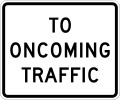




























































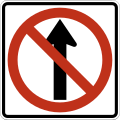

















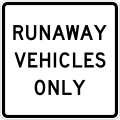














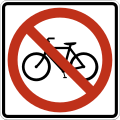


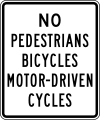
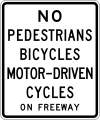









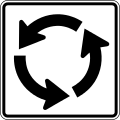


















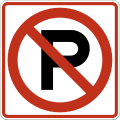












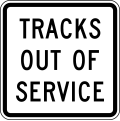












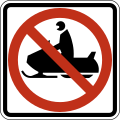
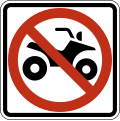





























![R10-15 Turning vehicles yield to pedestrians [b]](http://upload.wikimedia.org/wikipedia/commons/thumb/1/14/MUTCD_R10-15R.svg/120px-MUTCD_R10-15R.svg.png)
![R10-15a Turning vehicles stop to pedestrians [b]](http://upload.wikimedia.org/wikipedia/commons/thumb/9/9c/MUTCD_R10-15a.svg/120px-MUTCD_R10-15a.svg.png)
















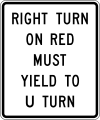


























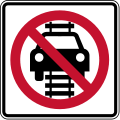
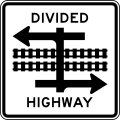












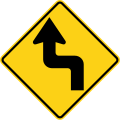
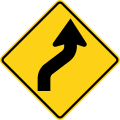



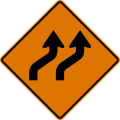
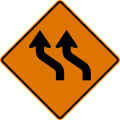









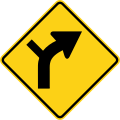





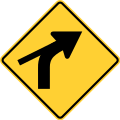




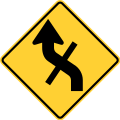





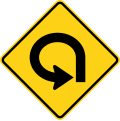

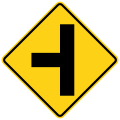











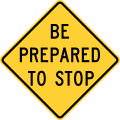


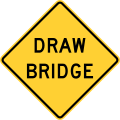



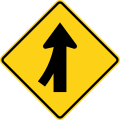


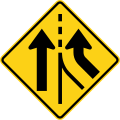










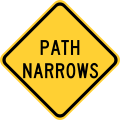
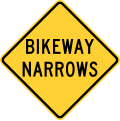























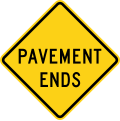


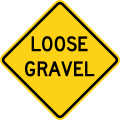








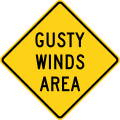









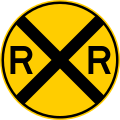




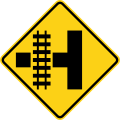

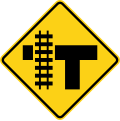
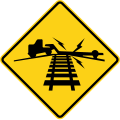













![W11-1 Bicycle[c]](http://upload.wikimedia.org/wikipedia/commons/thumb/4/4a/MUTCD_W11-1.svg/120px-MUTCD_W11-1.svg.png)
![W11-2 Pedestrians[c]](http://upload.wikimedia.org/wikipedia/commons/thumb/9/98/MUTCD_W11-2.svg/120px-MUTCD_W11-2.svg.png)
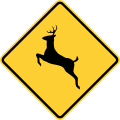





![W11-9 Handicapped[c]](http://upload.wikimedia.org/wikipedia/commons/thumb/7/71/MUTCD_W11-9.svg/120px-MUTCD_W11-9.svg.png)



![W11-15 Bicycle and pedestrians[c]](http://upload.wikimedia.org/wikipedia/commons/thumb/7/7d/MUTCD_W11-15.svg/120px-MUTCD_W11-15.svg.png)


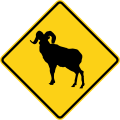



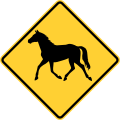










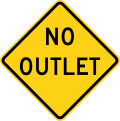

![W15-1 Playground[c]](http://upload.wikimedia.org/wikipedia/commons/thumb/c/cb/MUTCD_W15-1.svg/120px-MUTCD_W15-1.svg.png)






![W16-5PR Supplemental arrow to the right (plaque)[d]](http://upload.wikimedia.org/wikipedia/commons/thumb/e/eb/MUTCD_W16-5PR.svg/120px-MUTCD_W16-5PR.svg.png)
![W16-5PL Supplemental arrow to the left (plaque)[d]](http://upload.wikimedia.org/wikipedia/commons/thumb/6/60/MUTCD_W16-5PL.svg/120px-MUTCD_W16-5PL.svg.png)
![W16-6PR Supplemental arrow to the right (plaque)[d]](http://upload.wikimedia.org/wikipedia/commons/thumb/f/f0/MUTCD_W16-6PR.svg/120px-MUTCD_W16-6PR.svg.png)
![W16-6PL Supplemental arrow to the left (plaque)[d]](http://upload.wikimedia.org/wikipedia/commons/thumb/b/b8/MUTCD_W16-6PL.svg/120px-MUTCD_W16-6PL.svg.png)
![W16-7PR Downward diagonal arrow to the right (plaque)[d]](http://upload.wikimedia.org/wikipedia/commons/thumb/4/4c/MUTCD_W16-7PR.svg/120px-MUTCD_W16-7PR.svg.png)
![W16-7PL Downward diagonal arrow to the left (plaque)[d]](http://upload.wikimedia.org/wikipedia/commons/thumb/6/6a/MUTCD_W16-7PL.svg/120px-MUTCD_W16-7PL.svg.png)





































